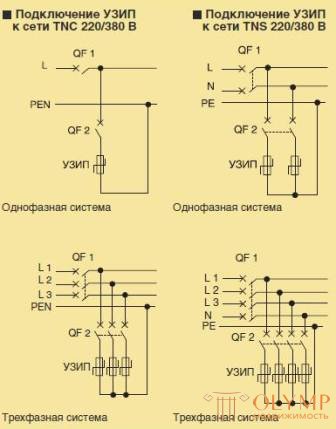
Thunderstorm discharges of atmospheric electricity can cause insulation damage, accidents in electrical installations, accidents with people and the destruction of buildings and structures.
The emergence of lightning discharges
When the sun heats the earth’s surface, there are rising air streams saturated with water vapor. Smaller particles of water are charged negatively, larger ones - positively.
Under the action of wind and gravity separation of oppositely charged particles occurs. Particles of water in the clouds, rising to a height of more than 5 km, freeze and collapse. Positively charged crystals are located in the upper part of the cloud, at an altitude of 5-7 km, negatively charged - at an altitude of 2-5 km. As a result of charge separation in the clouds, so-called space charges are formed, and the different parts of the thundercloud have a different size and sign of charge. The charges of the lower part of the cloud induce charges of opposite sign on the earth.
Between the clouds and the earth, as well as between different parts of the cloud or between different clouds, high-tension fields arise - several tens of thousands of volts per centimeter. When the field strength is about 30 kV / cm, air ionization occurs, a breakdown begins - the so-called leader discharge (a low-luminous channel with a diameter of 10–20 m), moving at an average speed of 200–300 km / s.
Under the influence of the field, charges on the ground - in areas with high conductivity (wet places, electrically conductive layers, etc.) or with high objects (hills, chimneys, water towers, pylons, wires of power lines, trees, standing alone on a plain building and so on) are moving towards the leader.
The leader goes to the object in relation to which the intensity of the electric field is the highest, and then there is a powerful counter discharge, propagating with a speed comparable to the speed of light (Fig. 1). In this case, during less than one ten-thousandth of a second, a current reaches hundreds of thousands of amperes through the affected structure, under the action of which the plasma heats up to several tens of thousands of degrees and begins to glow brightly.
The light effect of the discharge is perceived as lightning, and the explosive expansion of air in the discharge channel causes a sound effect - thunder.
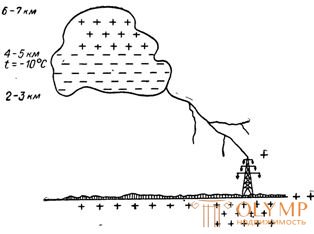
Fig. 1. Diagram of the process of electrification of a thundercloud and the development of a thunderstorm discharge on a ground object.
As the measurements showed, about 3/4 discharges arise from negatively charged parts of the cloud, 1/4 discharges from positively charged zones. Following the first several consecutive discharges may occur.
Thunderstorm discharges are characterized by the following parameters:
• current amplitude - a current of 10–30 kA is most often observed, in 5–6% of measurements the current reached a value of 100–200 kA;
• the wavefront length is the duration of the rise of the lightning current to its maximum value (usually 1.5-2 μs).
Much less frequently, ball lightning is observed, which is a glowing plasma ball up to half a meter in diameter, slowly moving under the influence of air flows along the surface of the earth. Fireball penetrates buildings through chimneys, windows, doors.
If ball lightning touches a living organism, there are deadly injuries, severe burns occur, and when in contact with structures, an explosion and mechanical destruction of objects occur. The nature of ball lightning is not well understood.
Protection against lightning is quite an important point in the electrical circuit of the house. If in an apartment building this is done by an organization serving the electrical network, then in a private housing stock it is often necessary to take everything into their own hands. But before we begin our story, we will rather briefly try to consider what lightning is and what it is like. Lightning is a natural discharge of electricity .
Conditions of occurrence of lightning.
1. Powerful vertical movement of air masses.
2. Enough humid air.
3. Large vertical temperature gradient.
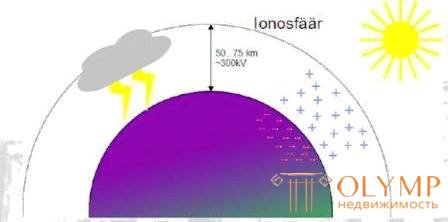
Lightning classification.
On the developing channel.
1. Directed to the bottom of the zipper.
2. Directed to the top of the zipper.
By the nature of the charge.
1. Negative lightning (90%).
2. Positive lightning (10%).
Lightning consists of one or several strokes.
1. Short lightning strike up to 2ms.
2. Long lightning strike more than 2ms.
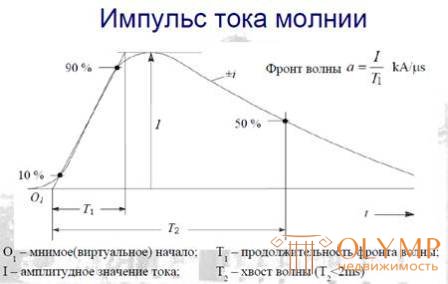
So our introduction is complete, as you have already noticed that we really did try to remind you of the knowledge of school in a very short form. Well, now go directly to our story today.
Impact of lightning current on buildings
Direct lightning strike causes splitting of supports, melting of structures, ignition and explosion, mechanical destruction, unacceptable heating of metal structures from lightning current flowing through them into the ground. According to exploitation data, lightning burns through sheet metal 4 mm thick.
Electrostatic induction is manifested in the creation of high potential metal structures and conductors isolated from the ground, leading to a breakdown to the ground, which in turn can cause electric shock, ignition and explosion of explosive mixtures, as well as insulation failure in electrical installations.
Electromagnetic induction manifests itself in inducting, at a discharge current, metal structures and communications (beams, rails, pipelines, etc.) of high potentials isolated from one another and from the ground, which can cause a spark or arc.
When a lightning discharge occurs, high potentials are also carried along external ground structures and communications.
Buildings and structures, depending on their purpose and intensity of thunderstorm activity in the area of their location, should be protected from lightning or secondary effects caused by lightning.
The territory from the Urals to Krasnoyarsk and the southern parts of Krasnoyarsk, from Krasnoyarsk to Khabarovsk belongs to localities with an average duration of thunderstorm activity from 40 to 60 hours. In the region north of Krasnoyarsk, from Krasnoyarsk to Nikolaevsk-on-Amur, the average duration of thunderstorm activity is from 20 to 40 hours. Increased thunderstorm activity from 60 to 80 hours per year is observed in the areas of Gorny Altai (Biysk — Gorno-Altaisk — Ust-Kamenogorsk). Lightning protection of buildings and structures should be carried out on projects developed by specialized organizations.
Lightning protection.
Lightning protection is internal ( Protection against secondary effects of lightning current ) and external ( Protection against direct lightning strikes. ). This is if you look deep into the matter, as if two security circuits, which, working together with each other, can almost completely protect your dwelling.
Protection against direct lightning strikes.
The area of the lightning rod
The effect of lightning protection devices is that a metal lightning rod towering above it is installed near the protected object, reliably connected to the ground. When a lightning discharge occurs, the leader rushing to the ground approaches the highest point having increased conductivity (such a point is the top of the grounded interception rod), and the discharge occurs on the interception rod bypassing the protected object.
The protection zone of a single rod lightning terrain with a height h is a cone with a height of 0.92 h with a base in the form of a circle with a radius of 1.5 h (Fig. 2).
All structures that fit into the cone will be protected from direct lightning strike with a reliability of at least 95% (Zone B). Inside a cone with a height of 0.85 h and a base radius of 1.1 h, the reliability of protection is 99.5%. (Zone A).
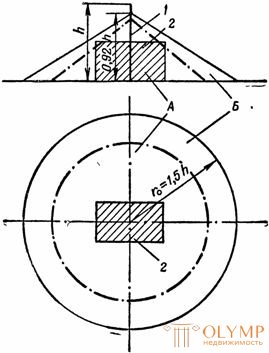
Fig. 2. Protection zones of a single rod lightning rod. And - a protection zone with reliability of 99,5%; B - protection zone with 95% reliability; 1 - lightning conductor; 2 - protected object.
If the area of the object is larger than the protected area, it is necessary to increase the height of the air conductor or install several lightning rods.
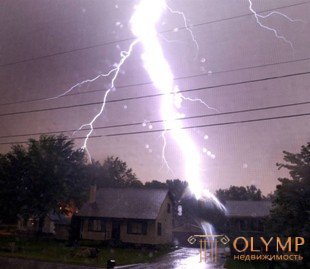
External protection. (Protection against direct lightning strikes.)
First of all, it is a lightning conductor, which is always installed on the highest point of the house, connected by a conductor to your grounding system.
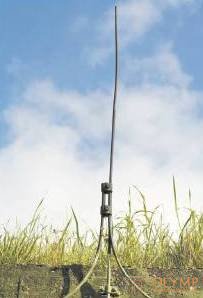
The task of the external lightning protection system is to catch the lightning discharge a fraction of a second before direct contact and send it to the ground leads.
The lightning rod that is installed on the roof is usually of two kinds.
1. High metal pin.
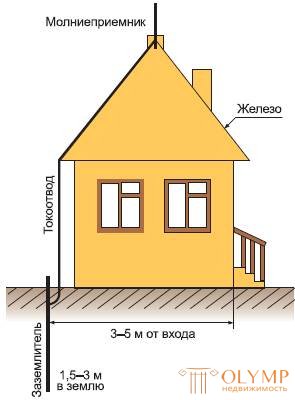
2. Cable, stretched along the entire ridge of the roof.
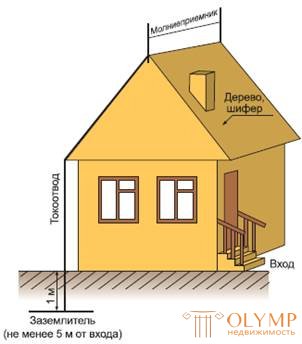
There is another option, and it consists in the fact that a metal grid welded from fittings with a cross section of 8–10 sq. Mm and with a step of cells usually constituting 2-6 meters, is laid on the roof of your dwelling.
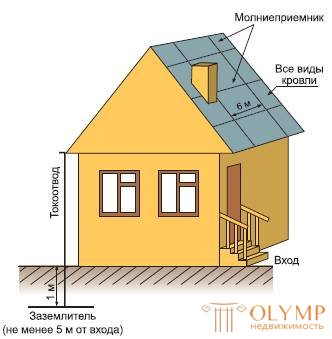
But in principle, there is not much difference between all these methods of lightning protection. The task of all one - to catch the discharge of lightning.
The lightning receiver cross section should be at least 12 sq. Mm, but of course it is better that your lightning receiver has a sectional stock. When installing the pin, you should always remember that it should rise not less than 30 cm above the highest point of the roof, the same applies to the cable receiver.
Here you should also remember one more thing. The zone that the lightning rod protects is approximately equal to its height. That is, at a height above ground for example 8m, it will protect the area of a circle with a radius of 8 meters from lightning. And below, we have tried to give you an example of a series of schematic drawings of lightning rods and zones that they can protect.
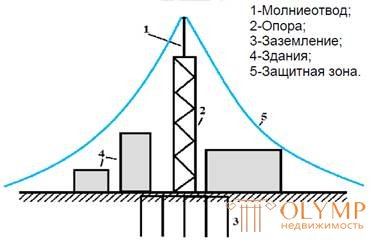
Picture 1.
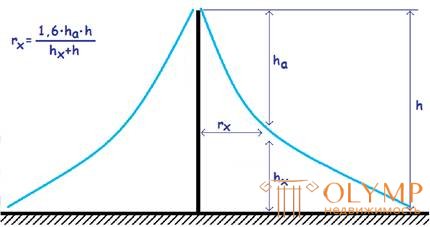
Figure 2.
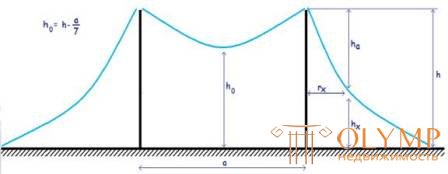
Figure 3.
The wire along which the lightning energy will go to the earth conductor, it is better to take a steel section of not less than 10 sq. Mm or copper with a section of not less than 6 sq. Mm. Here, this is the case when the thicker the better. The conductor is connected to the receiver by welding or by bolting. The conductor should not pass by metal elements closer than 30 cm.
Internal protection. Secondary lightning current protection
The main measure to combat the occurrence inside buildings or structures of high potentials due to electrostatic induction during atmospheric discharges is the grounding of all the conductive elements of the building.
To eliminate the effect of electromagnetic induction in extended metal elements (pipelines, metal structures, etc.), the latter are reliably connected with metal bridges.
To eliminate the introduction of high potentials through air and underground communications, the inputs of the power supply networks, radio installation, signaling and communications are cabled and valve-type arresters (for example, RVN-0.5) and spark gaps, triggered by an increase in voltage, are installed.
This type of protection is provided by special devices, which are usually added to the circuit of the house shield and WU (input device). The essence of these special devices in the following - suppose that the lightning does not enter the house, but during a thunderstorm, voltage surges quite often occur. This is due to the fact that the electromagnetic field at a lightning strike can create impulse currents in the wiring and all sorts of devices.
The discharge does not necessarily have to hit it in the house - it can happen at a distance. But if, after all, lightning enters the house, at best, the lightning conductor will release voltage to the grounding conductor, but at worst, the discharge will strike the electrical network of your house.
Even when the lightning energy flows through the lightning conductor, the current arising in the wiring can cause damage to sensitive equipment. Well, and with direct exposure, it is better not to imagine what might happen. And here we would like to present to your attention a rather interesting table - methods for the propagation of high-voltage atmospheric discharges.
Table 1. High-voltage atmospheric discharge. Methods of distribution.
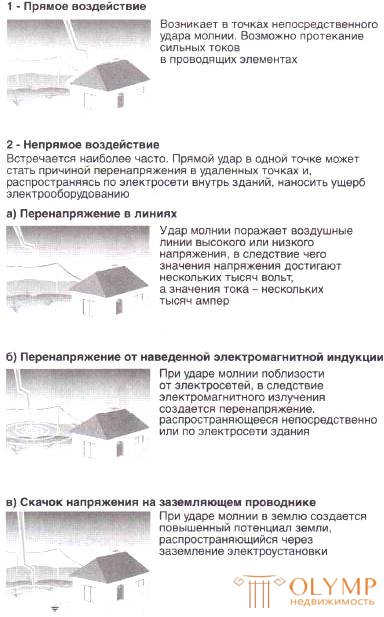
To prevent this from happening, there are special devices - limiters.
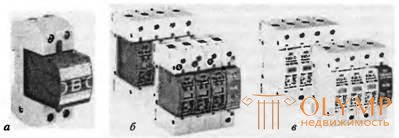
Figure 4.
A. Limiter category B.
B. Limiter category B + C.
B. Limiter category C.
There is also a category D limiter. It looks exactly the same as the limiters represented by us in this image. As you can see, these devices resemble conventional circuit breakers in their appearance, but without a disconnect lever. All you need to know about surge suppressors (arresters) is that they are installed between phase and ground or neutral wire and ground. The task of the limiters is to neutralize the surge voltage.
In practice, three types of limiters are mainly used - B, C, D.
1. Class B - these limiters are installed on during a shield. They are designed to protect against ultra-high voltage or in other words a direct lightning strike.
2. Class C - devices are installed according to the scheme after a class B arrester and serve as protection against induced currents.
3. Class D - installed when you are particularly sensitive devices in your home.
Always use all three types, because they have a different threshold of sensitivity, and set the scheme one by one. Arresters are designed for single-phase networks, and for three-phase.
Several schemes for connecting limiters:
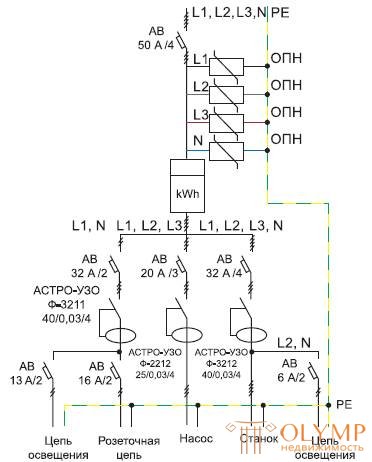
Diagram 1. The arrester connections, which are located between the input automat and the ground conductor, are three-phase.
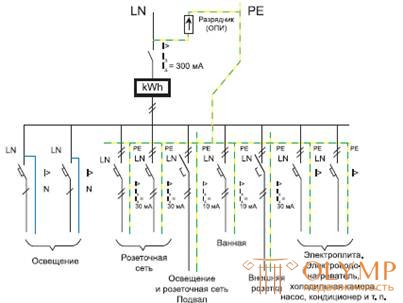
Scheme 2. Connecting the surge arrester, which are located between the input automat and the grounding conductor, the network is single-phase.
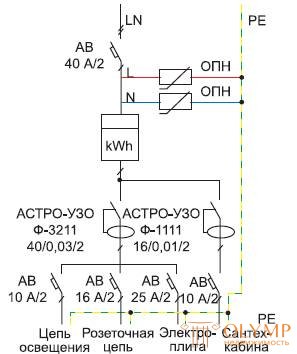
Scheme 3. Connecting the surge arrester with a single-phase circuit.
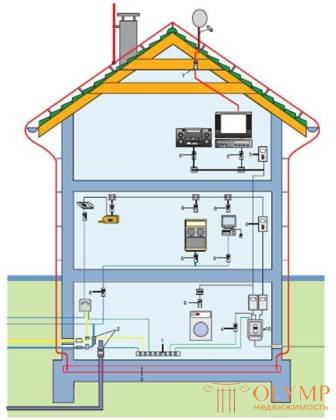

Figure 5. The use of various types of surge arresters to protect equipment currently in the house.
Images of some arresters or surge protective devices (surge protective device) of the Legrand line, as well as their connection diagrams:

Connection diagrams:

Note. Remember that all the diagrams are given for example. Everything can change when using other type of equipment.
And finally, we would like to give you one, probably already annoying advice. Do not save on the protection of your home. And buy all the equipment from trusted vendors. And then not any lightning will not be terrible neither to you nor to your housing.
Что бы оставить комментарий войдите
Комментарии (0)